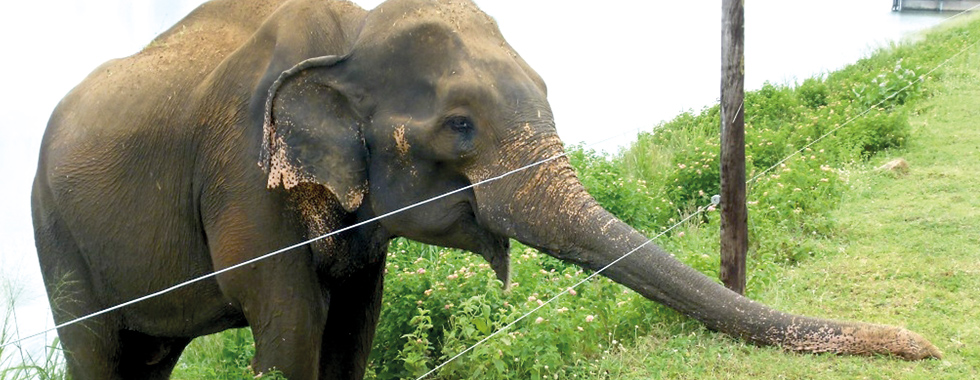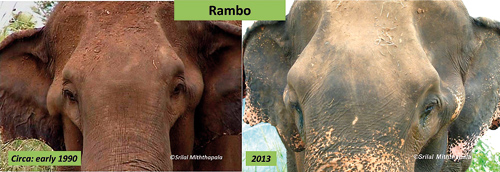Have you seen our gentle Rambo?
It was about 10-15 years ago that a big bull elephant was sighted regularly along the electric fence bordering the Thanamalwila Road that runs adjacent to the UdaWalawe National Park (UWNP). He was named Rambo. His demeanour was far from the real life movie Rambo, in that he was quite a calm character, who just wandered up and down the fence peering at the passers-by, who often stopped their vehicles to watch this magnificent and unique sight. Of course, given our typical Sri Lankan mentality of curiosity, it was only a matter of time before people started feeding Rambo with sugar cane and fruits procured from the street vendors along the road.

A familliar sight on the bund
In fact very soon, many other male elephants started emulating Rambo and frequenting the fence, so much so that at any given time there would be some 15-25 elephants close to the fence in the hope of getting some tasty tit-bit, from people passing in vehicles along the road.
No amount of efforts to prevent passers-by feeding the elephants was successful, and eventually it became a major attraction, providing unique photo opportunities of wild elephants in such close proximity.
There were many debates and controversies about this activity, and there were even some suggestions, that if it were properly controlled, this would be a good tourist attraction. However, all this changed about a year and half ago, when the Department of Wildlife Conservation (DWC) realised that they could not properly enforce the no- feeding rule along the Thanamalwila roadside, and erected a second electric fence behind the existing one. A large amount of money was spent on this second barrier, which extends from the end of the reservoir bund, right up to the corner of the park boundary on the Thanamalwila road up to the 25th Km post.
This has proven to be quite successful, and today there are no elephants along this stretch of the road.
However, the authorities had not bargained for Rambo. Unable to indulge in his favourite pastime, he started swimming across the edge of the reservoir and got on to the steep embankment along the reservoir bund, to access the roadway (where there was only a single fence) to solicit food from vehicles passing by.
While this is quite an amusing and intriguing sight, which attracted a lot of attention, there was concern that Rambo was getting too dependent on this type of food. He seemed to be quite content to stay along the bund, eating whatever little vegetation there was and wait for the additional favourite ‘titbits’ given by passers-by.
Dr. Vijitha Perera, Senior Wildlife Veterinarian, DWC told me that Rambo more or less spends most of his time on the bund, which means that he may not be getting adequate nutrition from anywhere else. In fact, a closer look at Rambo revealed that his body condition was not that great.
No doubt, he was advancing in age (he would be about 40 years now), but I still felt that the deterioration could be because he is not getting enough proper food. The DWC had tried on several occasions to chase him back into the park, by lighting elephant deterrent fire crackers (aliwedi), but apparently, he swam back across after the authorities left.

Last week Dr. Vijitha said he had noticed another disturbing observation where Rambo’s legs and belly were swollen and distended. He felt this was because Rambo was not getting any sleep, or proper exercise by staying on the bund continuously, and that his body weight was causing fluid to collect in his lower extremities.
Dr. Vijitha had begun treating him, and also had tried feeding him more nutritious food. However, last Saturday I received a call from Dr. Vijitha that Rambo was missing from the bund. If he has gone back into the park, then on the one hand it may be a good sign but the veterinary surgeon needs to monitor him and continue the treatment. On the other hand, he may have gone back into the park and collapsed somewhere.
All the trackers have been alerted to keep a look out for Rambo. But given his demeanour and the behaviour he has learned over many years, it is difficult to imagine that he would suddenly stay away from his favourite haunt for so long, unless he is badly ill, or something more serious has happened to him.
This is the direct result of foolish people feeding wild animals and habituating them to human interaction. Rambo is but just one example. Gemunu, the large and infamous tusker of Yala National Park, who was in the news recently, is another case in point. The Torque Macaque monkeys in the Polonnaruwa sacred area is another. When such intelligent elephants get used to these forms of behaviour it is very difficult to make them ‘unlearn’ it.
They end up being neither tame, nor wild, and eventually, when they become too belligerent ( like in the case of Gemunu who now brazenly walks up to the jeeps and puts his whole head in to look for food), the DWC is forced to resort to translocating the animal to some other location. Being very intelligent animals that have strong home-range fidelity, this is virtually signing a ‘death warrant’ on the animal. He tries to find his way back, stumbles across village hamlets, gets shot at, and eventually succumbs to his injuries dying a slow and sometimes agonizing death in some faraway place.
It is indeed sad that we do not pay enough attention to such iconic individuals and make special efforts to safeguard them. They are the ones who create the human interest stories with their charismatic personalities. This in turn fuels public interest and opinion, and helps publicise and draw attention to the plight that is befalling these gentle giants of our island.
comments powered by Disqus

